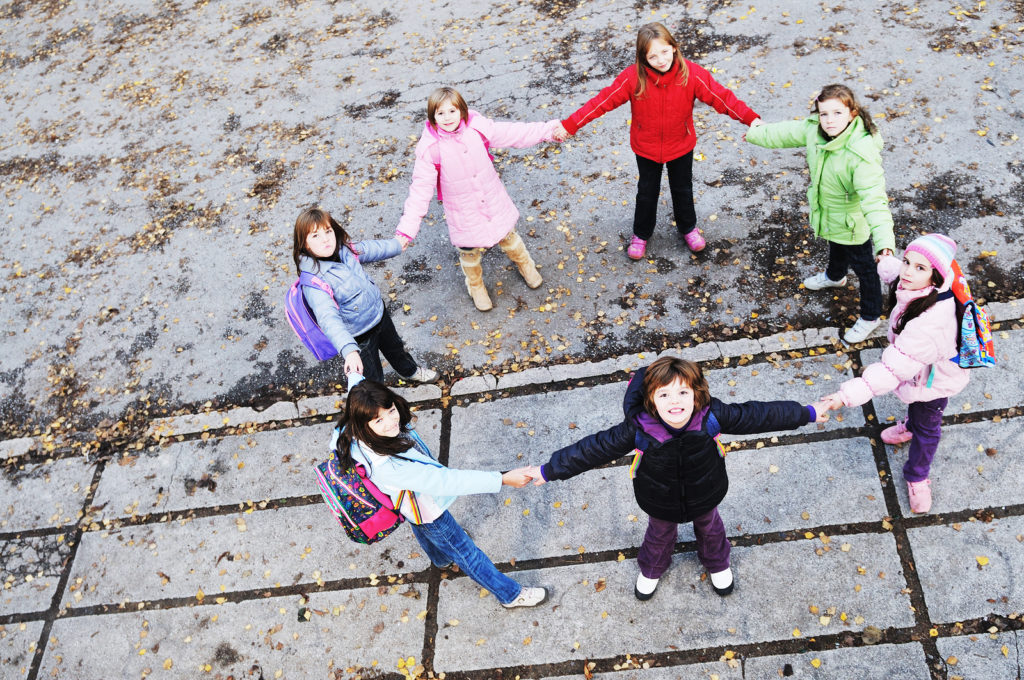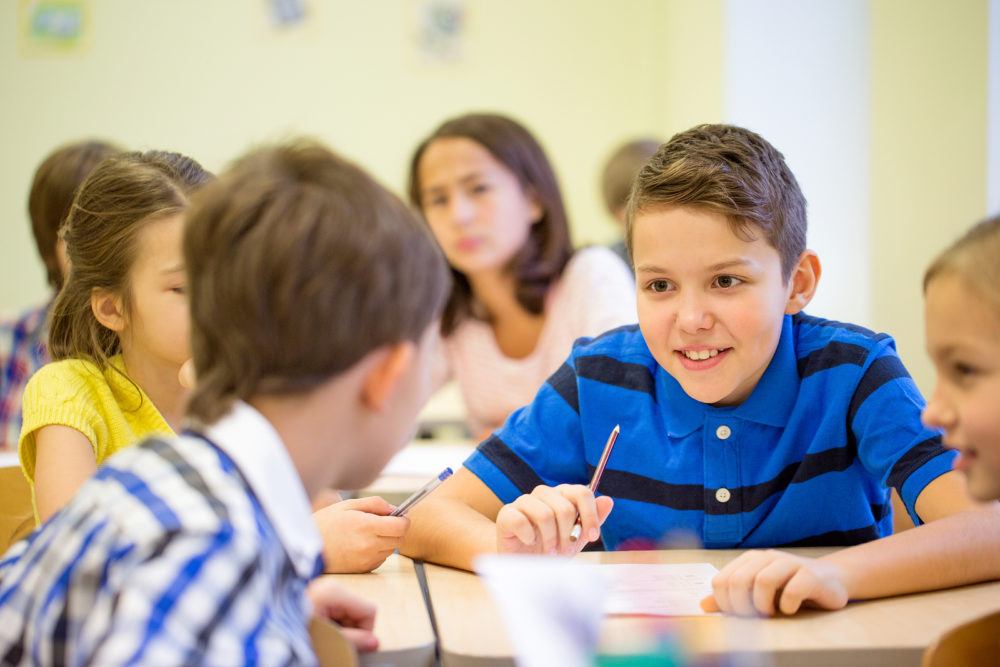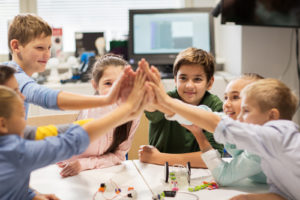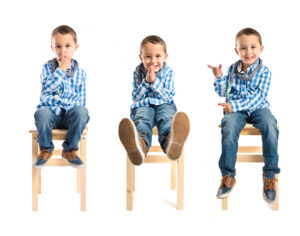11 Total Participation Techniques That Involve Movement
11/8/2017

"Simple biology supports the obvious link between movement and learning" (Jensen, 2005).
Jensen explains that oxygen is necessary for brain function, more blood flow equals more oxygen and physical activity increases blood flow (2005). Other outcomes of increased movement are: more cortical mass, greater number of connections among neurons, and gene expression to improve learning and memory (Jensen, 2005).
Why is this so important? Kids need to interact and process the material presented to them. When one gets up and gets active, it gives more energy to do what needs to be done. There have been so many teacher workshops where I just sat and took in information for many hours only to find myself daydreaming, making lists, and working hard to not doze off. The brain research from David Sousa informs us that the brain needs more oxygen for fuel. The higher the concentrations of oxygen in the blood, which is created by movement, the stronger the cognitive abilities are in our students. (Sousa, 2006). Sousa goes on to tell us that if students can get up in a lesson, move around and talk about their learning (Sousa, 2006), the more learning will occur for these students. Using the concepts from Total Participation Techniques from Persida and William Himmele, I will share 11 of their movement activities that encourage students to get out of their seats, manipulate objects, talk with one another, and process learning together.
1 - Line Ups and Inside Out Circles
This strategy allows students to get out of their seats to share discussion with different people in the class. This is a Kagan-inspired strategy that allows students to be randomly paired with kids from their class. I like to use this in my Daily 5 reading time where I am having students interacting with their free choice text. I put a focus question on the board such as, who is the main character in your story? Or, my character is a strong (or a weak) main character because…. I have the students reflect, write an answer on sticky notes or just take a few minutes to formulate their answer by themselves before we move. I have a large class so I then line my students up in two circles. The inside circle is smaller and the outside circle a little bigger. They face each other. I have them share their thoughts about the question with the person across from them. They may bring their notes or their book with them as a reference. They take turns talking over their answers. This usually leads to more questions about each other's books. I then ask the outside circle to take two steps to the left until they are in front of a new person. They now talk about the same prompt to a new person. As kids are moving around their circles, I move around the lines, listening to their conversations to see who has a developed sense of character and who needs more work on character development. This strategy works best with more open-ended, opinions, judgments, or prompts that need one to justify his or her rationale. If you ask a literal or fact-based question, your line up technique will not be as successful or as powerful. This works with all subjects and it helps me if I spend time thinking about what the big ideas of the unit are and then create prompts to use throughout the lessons. This helps students learn to converse back and forth and develop more detailed answers to satisfy their partners who are listening to them.
2 - Three 3's in a Row
This is a great technique to use to develop listening, summarizing and critical thinking skills. Students are given a template with nine boxes and those boxes have questions the teacher prepares inside them. Students move around to their classmates and they listen to each other and get information from their peer "experts". Students have to summarize what the peer expert stated and then summarize their answer into the corresponding box. The owner of the template is the one who must write the answer in the box. This is crucial because it helps them engage with what their peer said and it helps the student develop the processing skills through listening to each other. If you let others write on the template, then it becomes very passive. The students can only use a peer one time for a question so they will be talking to nine different students. The teacher's job is to walk around and see the quick assessment of what the students have learned well. The question boxes that remain blank let me know what is still difficult for my students. After students have finished, share out as a class what they learned. Higher order questions allow students to synthesize, analyze, and evaluate the components of the concepts.
3 - Networking Sessions
This simple activity encourages kids to talk to others they usually do not talk to. It helps build community in the classroom so I really like to use it at the beginning of the year while I am building my community culture. I prepare up to four prompts or questions and then I have the students prepare their answers first. I then have them find someone they have not spoken to that day to share the answers to the prompt or question. I play music while they are sharing and then when the music stops, they thank their partner and go find someone else they have not talked with to be their second person. We repeat this through the four questions. In our first science investigation, we used this technique and the students answered the following questions: Explain why mass and release position changes how a pendulum swings. Second, why did the swinger decrease the number of times it could swing in 15 seconds if the length of the swinger changed? Third, what generalizations can be made about pendulums and their length, mass, and release position and fourth, what other pendulums can you think of in your world and what are they most affected by: the mass, length, or release position?

4 - Categorizing & Sorting
This technique helps students understand characteristics of concepts that are varied. Some examples include geometric shapes, prime and composite numbers, factors, multiples, short and long vowels. This provides students with opportunities to see how we can sort different ways and still be correct. I have pulled books and asked students to sort them according to their genres. The students must have a reason for placing the books in specific categories. When categorizing, have the students generate the titles for each category as they make their groups. When sorting, the teacher determines the names and traits for the groups and the students sort within those piles. This technique helps students understand features of the concepts that are being presented and it helps them pay attention to specific traits needed for understanding the overarching concepts. This also helps them develop their ability to justify their reasoning for the way they have categorized or sorted.
5 - Appointment Agendas
Students make appointments with other students to give them another variety of partners to talk or work with during lessons. I let them choose the first five people and then I fill in their choices for the rest of the appointments. Each person can only be on an appointment card one time. As they walk around to a partner they want to talk with, they find a slot both have open and then write each other's name on that time slot. I have them keep a copy in their book boxes and I keep one as well. I use these when I want students to share their Quick-Writes or Quick Draws with a partner. After reading the book, Total Participation Techniques: Making Every Student an Active Learner, by Persida and William Himmele, I now go a step further in my appointment share outs. Once we share with our specific appointments, I have those pairs join another pair and now share in a small group. What I have found is when I keep adding to the pairs, my students are sharing more openly and staying more engaged. When I was asking them to share whole group, I would have some students disengage and wait for others to do the talking. When the groups were smaller, they were more likely to continuing sharing their responses.
6 - Bounce Cards
These cards give my students something to say when they are stuck, shy or just need a starter to help them get the discussion going. When I have my students get into one of their predetermined small groups to do a book talk or discussion, they pull out their Bounce Cards to help them with starters when they are stuck. I start when I teach the 10 Steps to Independence (Daily 5). During these steps, we model the right way and the wrong way to do something. I model with another student the right way to have a discussion and the wrong way and I emphasize that we are bouncing ideas and/or conversation off each other. They can either Bounce, or take an idea and bounce it off their group members, Sum It Up, or rephrase what someone else has said, or finally, they can Ask a Question regarding what their peers say. The more I can do guided practice with this technique, the more effective it is when I release control and let them engage in small group discussions. I will model for the first few weeks of school and then release the control by letting them decide when it is time to go on to the next prompt. I always debrief when finished with these discussions as it helps them share what was hard and what went well during these discussion groups.

7 - Feature Walk
This technique allows students to get up out of their seats to work in small groups. Text features work well with this technique as students can analyze pictures, diagrams, maps, charts, tables, graphs, and any other supports that will aid in the comprehension of a text. Choose four features from the text and make enlarged, page sized photocopies. I have 26 students so I make three sets of the four pictures and put my students in their predetermined groups of three. I like groups of three because then everyone talks and shares in the groups. I hang these picture sets all around my room and I have the students move through the room and discuss a prompt I give them to answer while analyzing the pictures. Some prompts I have used include: how does this text feature help you understand (the topic) better? Why would I have chosen these pictures as important to focus on today? What is the message being conveyed by using these pictures? Brainstorm all the people who would be affected by the meaning behind this text feature. Tell how they are being affected by this feature. The most important thing about this picture or text feature is…... I let them reflect individually first and then I have them share with each other. After a few minutes, I ring my chimes and they all move the same direction to look at the next picture or text feature. The silent processing minute I give them is critical in encouraging students to think below the surface and develop their thoughts regarding the text feature. I find their answers to be stronger and more thoughtful when I give them this time to develop their answers.
8 - Citation Walk
This technique is like the Feature Walk in procedure but they are focusing on a citation or quotation from the text or resource on the topic being studied. I post these citations/quotations around the room and students move like in the Feature Walk and discuss how it relates to the topic we are studying. I might give a prompt that asks them to figure out why I would have chosen that citation/quotation or what the author really meant when he or she wrote it. They may discuss what the bigger message is that is being conveyed. Again, it is important to give the students time to silently process their answers before sharing out what they think.
9 - Mouth It, Air Write It, and Other Individual Response Formats
This technique works very well for early primary students as they can silently mouth the response by forming the answer on their lips. They do not make any sound from their mouths. I love to use this when students are wound up and having trouble maintaining a quiet learning environment. When they are sounding out the word cat it looks a lot different than sounding the word rat even though the endings are the same. They can Air Write the answer or write it on the floor with their fingers. This works well with writing initial sounds, numbers or letter/number formations. I have my fifth graders whisper to their neighbor answers to math problems after they have showed me on their white boards. Younger students love it when we ask them to change their responses by whispering instead of speaking out loud at carpet time. The technique, Show Me with Your Fingers works well when I am reviewing for a test or give them questions that have multiple choice options. If the answer is A, I have them hold up one finger, 2 for B, 3 for C and so on.

10 - Acting It Out, Role Plays, and Concept Charades
Acting things out or demonstrating comprehension using the body can allow students to process what they really know about a concept (Himmele, 2017). Kids can draw things in the air, act out a certain science concept such as how molecules are formed or what a state of matter looks like. In the book, Total Participation techniques: Making Every Student an Active Learner, by Himmele, they gave a great example about fifth graders acting out motor control by creating the "nervous system game". Students acted as messengers carrying messages along the central nervous system. Science lends itself to acting out so many things that will better help students understand complex concepts. Vocabulary also goes well with drama. Words can produce images and when one can add actions to go along with the word, the word will stay in long term memory. In the concept of Zoo Phonics, a kindergarten letter/sound program, hand movements are connected to the word. Months later when I say nothing and instead simply act out the word using the hand motions I showed them months earlier, the students can produce the sound and/or letter name. In history, one can act out war scenes or artifacts used during a certain time period. In literacy, one can act out genres, such as fantasy, nonfiction, poetry, and autobiographies. By acting out these complex concepts, it gets students out of their seats, processing using higher order thinking to analyze what motions should be associated with certain words or concepts. My students get nervous to act out in front of their peers, but are much more successful when we do this activity in small groups. There is less pressure when it feels like less people are watching.
11 - Simulations
This is a technique used to create relevance for students. The idea is to create a scenario they can relate to and use that to compare it to an event say in history that they may have no connection. This year we will be studying how a bill becomes a law. To give that process meaning to students, we will set up our own government and write our own bills and fight to get them passed through the Senate and the House and finally signed into law. We will use our principal, our needs at our own school, and create laws that will help better our school. Students tend to become emotionally involved and when that happens, there is a connection, a relevance, and long-term learning that occurs.
By using these techniques that get our students up and moving, we are ensuring that we are helping our students become engaged in deep, meaningful and lasting learning. Activity using these Total Participation Techniques help students shine because we are giving them the opportunity to demonstrate higher-order thinking through this interaction. I see my students doing the work to engage in this deep learning and they are having fun doing it as well!
References
- Himmele, P. & Himmele, W. (2017) Total Participation Techniques: Making Every Student an Active Learner (2nd ed.). Alexandria, VA: ASCD.
- Jensen, E. (2005). Teaching with the brain in mind. (2nd edition). Alexandria, VA: ASCD.
- Sousa, D. A. (2006). How the Brain Learns (3rd ed.). Thousand Oaks, CA: Corwin Press.
- A 5th Grade Teacher’s Guide to Surviving October - October 10, 2018
- Dear Students… Here are the 5 Big Ideas I Hope You Learned This Year - May 21, 2018
- 11 Strategies to Encourage Students to Own Their Learning - January 19, 2018











